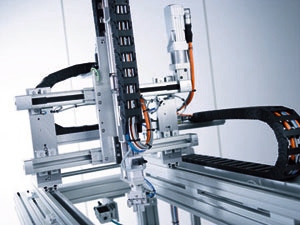The Pneumatic-Electromechanical Connection
April 21, 2011

The strength of standard pneumatics has always been itsability to provide cost-effective, discrete end-to-end movements which, byemploying specific valves (5/3 way), can achieve a mid-position that offers lowrepetition accuracy at best.
The Pneumatic-Electromechanical Connection_A |
But now, servo pneumatics isemerging as a technology that offers the flexibility of multi-position andforce control with position and velocity monitoring. Positioning and forcetasks can now be linked and sequenced, reducing PLC I/O requirements andprogramming complexity. Servo pneumatics makes this possible by employingactuators in conjunction with feedback devices to form a multi-position,servo-pneumatic system.
"The power of servo pneumaticsis that it bridges discrete standard pneumaticsand the electromechanical solutions available in the market today," says NuzhaYakoob, product manager - positioning for FestoCorp. "Pneumatics offers benefits such as simplicity, robust operation,compactness and high-force densities, which make the technology desirable withsystems that are simple to operate and implement, and have demands that cannotbe met by electromechanical solutions."
With the trends in the markettoday pushing the need for more flexibility and on-the-fly adjustments, thereis a move toward transforming pneumatic systems into more electronic andsoftware-oriented solutions. Engineers can implement systems that are 100percent electric and, since the power source is no longer air, any lossessustained in maintaining pressure in the pneumatic cylinders is eliminated. Thetendency to migrate to electric solutions is due to the fact that electricsystems consume energy to operate on demand unlike pneumatic systems whichrequire air pressure to be maintained. But, according to Yakoob, somewhere inthe middle electromechanical systems often don't meet the speeds and forcedensities of pneumatics when comparing similar footprints.
When there is a need forbalance between cost and flexibility, and the need for precise movements in thefive to 10 micron-range is not required, servo pneumatics fits that gap.
The Pneumatic-Electromechanical Connection |
It takes the best of bothworlds and combines the flexibility and software control of electromechanicalsystems with the speeds and feed force advantages inherent with pneumatic axes.It brings together the best of both and fits well into the complete landscapeof positioning technologies.
Filling System Design Gaps
"Thesweet spot for servo pneumatics is in addressing application needs that can'tbe fulfilled by other existing electromechanical and linear motortechnologies," says Yakoob. "When there is a need to move large loadscontinuously (24/7 or high-duty cycle operation) on positioning systemsoperating on a low voltage, or when space constraints requiring high feedforces and high dynamics are an issue, the servo pneumatic axis becomes asuitable solution."
One advantage to pneumatics is that it doesn't have the motoroverloading and heating issues than can occur with an electrical system. With apneumatic cylinder, the application has the flexibility that comes with arepetition accuracy of plus or minus 0.2 mm compared to a linear motor system that mightoffer three micron repetition accuracy.
Areas where servo pneumaticsfit best include handling of hazardous products such as explosives, where youcan't guarantee the surrounding air is free of explosive gases. Also, if thereis a need to operate on a low voltage, servo pneumatic systems are appropriatebecause they can operate on a 24V dc supply.
Handling large loadsdefinitely differentiates pneumatics from electromechanical solutions becauseit becomes more cost-effective, and the technology provides high-force density,which helps to create more compact designs. To achieve the same feed forcesfrom an electromechanical system typically requires a much larger footprint andtherefore results in a more costly solution.
While servo pneumatics isbasically a pneumatic system that uses feedback, the controller offers analgorithm that differs from an electromechanical system and takes manyparameters into consideration. For example, temperature has an immediate impacton the volume and quality of air, and the orientation and frictional forces areall factored into this algorithm in the controller.
Yakoob says that servo pneumatic product offerings are verylimited in the market and Festo's goal is to offer a range of positioningtechnologies to meet the various application needs of its customers providingboth optimized performance and cost. An axis can do positioning, and also provides force control for clamping and pressing applications.
Festo's system approachcomprises a series of technology modules including a software controller thatresides on its CPX platform and a CMPX (Soft Stop) module, which is an end-positioncontroller or electronic shock absorber. A third measurement node (CMIX) offersdigital measurement of position data with repetition accuracy of plus or minus 0.01 mmprecise. Velocity data can also be measured.
About the Author(s)
You May Also Like






.jpg?width=300&auto=webp&quality=80&disable=upscale)

